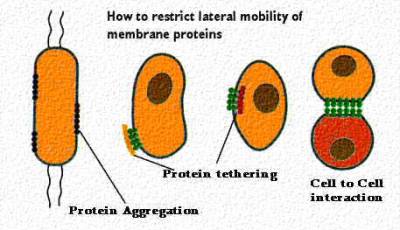| Section categories |
|
Related Subjects [38]
This category includes brief overview of all related subjects.
|
|
Defining BioInformatics [7]
In this section we tried to briefly explain what bioinformatics is ?
|
|
Unviersities [30]
This contains information about universities that are offering bioinformatics degree programs.
|
|
Resources [24]
Contains information about bioinformatics resources including databases, tools and techniques.
|
|
Algorithms [31]
This category includes some of the basic algorithms that are usually used by bioinformaticians.
|
|
| Statistics |
Total online: 1 Guests: 1 Users: 0 |
|
Home » 2011 » June » 19 » Membrane Structure
8:11 PM Membrane Structure |
Membrane Structure
Domains and Microdomains
How membranes support cell polarity, signaling, and unique functional sites.
Polarized cells have one side facing a special region in an organ and the other side facing another region. For example, in the intestine, the lining cells are polarized in that they express distinct structural and functional domains. See this site for more detailed information. The side responsible for absorption of nutrients faces the lumen. The lateral surfaces are specialized with barriers to entry and the basal surface is specialized to send nutrients and water to the blood stream. Each specialization is conferred by proteins associated with the membrane. This figure below was taken from Alberts et al. Molecular Biology of the Cell, Third Edition, Garland Publishing, N.Y., 1994, Figure 10-37.
One can prevent mobility of proteins in a lipid bilayer either by structures in or on the cell, or by experimental means. For example, as we will see in the section on tight junctions, apical proteins may be tethered and prevented from entering the lateral or basal domains. The tight junction that actually fuses the membranes in places may help to prevent entry as well, although this may be controversial.
How are the domains and microdomains formed and maintained ?

Earlier in this presentation, we discussed the interaction of sphingomyelins and cholesterol forming rafts or platforms that allow protein attachment. This helps organize the membrane into functional microdomains. A microdomain can be considered a functional unit that involves different types of proteins, enzymes etc. Certain types of junctions or signaling cascades could work out of microdomains. The above figure from your text shows ways that membranes can be organized into domains and microdomains.
As shown in the first text figure, above: complexes of proteins such as receptors, those involved in second messenger signaling, or those in specialized junctions are often aggregated in one region of the cell perhaps by interactions with sphingomyelins and cholesterol platforms or rafts.
In the middle figures: Proteins can be tethered by interactions with macromolecules outside the cell (like extracellular matrix), or inside the cell (for example, cytoskeletal filaments).
In the right hand figure, a complex of proteins can interact with proteins on another cell and be tethered in this way. This figure was taken from Alberts et al. Molecular Biology of the Cell, Third Edition, Garland Publishing, N.Y., 1994, Figure 10-39 An example of such an interaction can be found in one type of junction, called the gap junction.
|
|
|
Category: Related Subjects |
Views: 1354 |
Added by: Ansari
| Rating: 0.0/0 |
|
|
|




